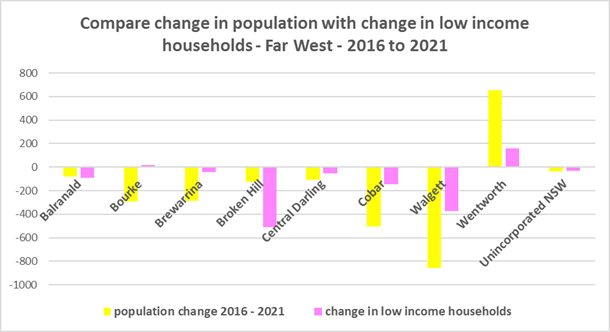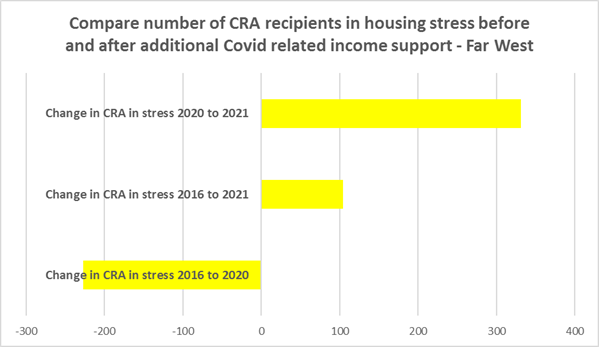Housing Market Snapshot – Far West Region
The Housing story in the Far West
The Far West region is comprised of the eight local government areas of Balranald, Bourke, Brewarrina, Broken Hill, Central Darling, Cobar, Walgett and Wentworth and also includes Unincorporated NSW. It covers a vast and diverse area, bordering Queensland, South Australia and Victoria, and comprising 40% of the land area of NSW.
The region has experienced population decline over the past two decades, largely due to changes in the mining industry - including an increasingly transient fly-in-fly-out mining workforce - as well as changes to agricultural practices. Clearly this has an impact on the demand for housing.
What’s the housing demand?
Between 2016 and 2021, the population of the Far West region declined by -3.7%. Every LGA within the Far West region experienced population decline, except for Wentworth, which increased by 9.6%.
Generally, most LGAs in the region have higher proportions of 0-14, 25-34 and 55-64 year olds and lower proportions of 15-24, 35-54, 75-84 and 85+ year olds than the average for the Rest of NSW.
As the largest centre servicing the region, Broken Hill differs from this profile – with lower proportions of age cohorts under 25 years and aged 35-54 and higher proportions of older residents than the Rest of NSW average.
Household types in the Far West are quite different to the average for the Rest of NSW. For the Far West region as a whole, lone person households are the largest household type comprising 28.5%, followed by couple families without children (22.9%), couple families with children (18.4%), other households (16.4%) and one parent families (10.5%). There is a significant proportion of other household types in this region (including multi-family households) – much greater than the Rest of NSW average (6.5%). Although there should be plenty of housing suitable for families of different sizes, there is also a need for a variety of dwellings with different bedroom numbers to suit couples and single person households.
At the 2021 Census, low income households comprise the largest proportion of all households in the Rest of NSW, in the Far West as a whole and in all but two of the region’s LGAs/areas (Cobar and Unincorporated NSW). Between 2016 and 2021 the number of low and moderate income households declined in the Far West region and most LGA’s while the number of high income households increased overall in the region but not every LGA. There are high levels of poverty and disadvantage in this region.
What’s happening in the market?
Historically the Far West has been and continues to be more affordable for both purchase and rental by lower income households than the average for the Rest of NSW.
Looking at all residential rentals combined together, there has been some variability but mostly the Far West LGAs have seen strong increases in median rents, since around 2010 and particularly post Covid.
Generally across the regions of NSW and in Sydney the vacancy rate has been tight, well below 3%, for a year or more. The Real Estate Institute of NSW hasn’t calculated a vacancy rate for the Far West at April 2023, but in neighbouring Orana it is 1.4%, the Riverina 0.9% and New England North West 2.1%.
Across the Far West the proportion of very low income rental households in housing stress is 77.2%, while 38.7% of low income rental households are also in housing stress.
Between 2017 and 2022 the region experienced a significant decline in affordable rental bonds lodged – with 40.1% fewer affordable bonds lodged and only 166 affordable rental bonds lodged at 2022. This is a strong indicator of dwindling affordable rental supply.
Broken Hill is the only LGA in Far West NSW with sufficient data on sales to determine the change in the median sales price over a longer time frame. Between 2012 and 2022 the median sales price for all dwellings in Broken Hill increased by 39.3%. While purchase affordability for very low income households has waxed and waned over the period from 2001 to 2021, for Broken Hill it is lower in 2021 than in 2001. 80.3% of sales at 2021 were affordable for purchase by very low income households in Broken Hill. For low income households 100% of sales were affordable for purchase.
Not surprisingly, the number of very low and low income purchasers in stress in Far West NSW is significantly lower than the number of very low and low income renters in stress in the region.
What’s happening with supply – and is it a good match?
The majority of households in the Far West Region are lone person or couple households, yet the housing stock is overwhelmingly detached homes with three or four bedrooms. Generally the region has insufficient diversity in housing type or bedroom mix and consequently there is little housing choice for households requiring smaller homes.
At the 2021 Census there were 19,728 dwellings in the Far West region. Of these, 80.3% were occupied (up from 78.0% in 2016), well under the 89.0% average percentage occupied in the Rest of NSW. This means 19.7% were unoccupied (down from 21.9% in 2016) and compared to 11.0% in the Rest of NSW.
The vast majority of occupied dwellings in the Far West were separate houses, comprising 90.5% of all occupied dwellings, compared to 82.5% in the Rest of NSW. The region has an unusually high number of people living in improvised dwellings.
As well as a lack of diversity in dwelling type, the region has little variation in the number of bedrooms per dwelling, with 46.8% of dwellings having three bedrooms and a further 26.6% having four or more bedrooms. Only 0.5% of homes are studios, 5.1% have one bedroom and 17.9% have two bedrooms in the Far West. While it is encouraging that there have been increases in the proportion of studio, one and two bedroom homes between the 2016 and 2021 Census, ideally there should be a closer match between household size and bedroom number to offer some housing choice for residents. The forecast increase in older age groups in the Far West means that there is likely to be more demand for smaller, more manageable dwellings. Two bedroom dwellings in particular offer the most flexibility, given they are also suitable for small families and allow older residents to have family members or carers to stay while giving them a more manageable size home to maintain.
Historically the Far West has been and continues to be more affordable for rent and for purchase by lower income households than the average for the Rest of NSW. However, a NSW Council of Social Service study released in April 2023 (Mapping Economic Disadvantage in NSW – 2021) found that in 2021 Far West NSW had the second highest rate of poverty in regional NSW – with 24.8% of the population being in poverty. Given the rate of poverty in the Far West and the level of disadvantage amongst Aboriginal and Torres Strait Islander residents, there is a need for more affordable rental housing for lower income households in this region.
Innovative solutions through partnerships with community housing providers and other not for profit local organisations might present the best opportunity to provide more affordable and diverse housing for lower income households in need in the Far West.
Change 2016 to 2021

Comparative statistics
- Number of dwellings at 2021: 19,728
- Population at 2021: 42,998
- Number of households: 18,949
- Number of rental households at 2021: 4,552
- The number of Very Low and Low income households at 2021: 7,726
- Number of Very Low and Low income rental households at 2021: 1,095
- Number of Very Low and Low Income Renters in Housing Stress at 2021: 635
- Decline in number of new bonds lodged affordable to low income households (2017-2021): - 111
- Number of New Bonds Lodged Affordable for low income households 2021: 166
- Number of Homeless at 2021: 258
- Number of Marginally Housed at 2021: 383
Key regional statistics
- Number of lone person households: 5,392
- Number of couple only households: 4,348
- Number of studio dwellings: 85
- Number of one bedroom dwellings: 885
- Number of caravan, cabin, houseboat dwellings: 106
- Number of unoccupied dwellings: 3,883

Additional information
Additional information on: